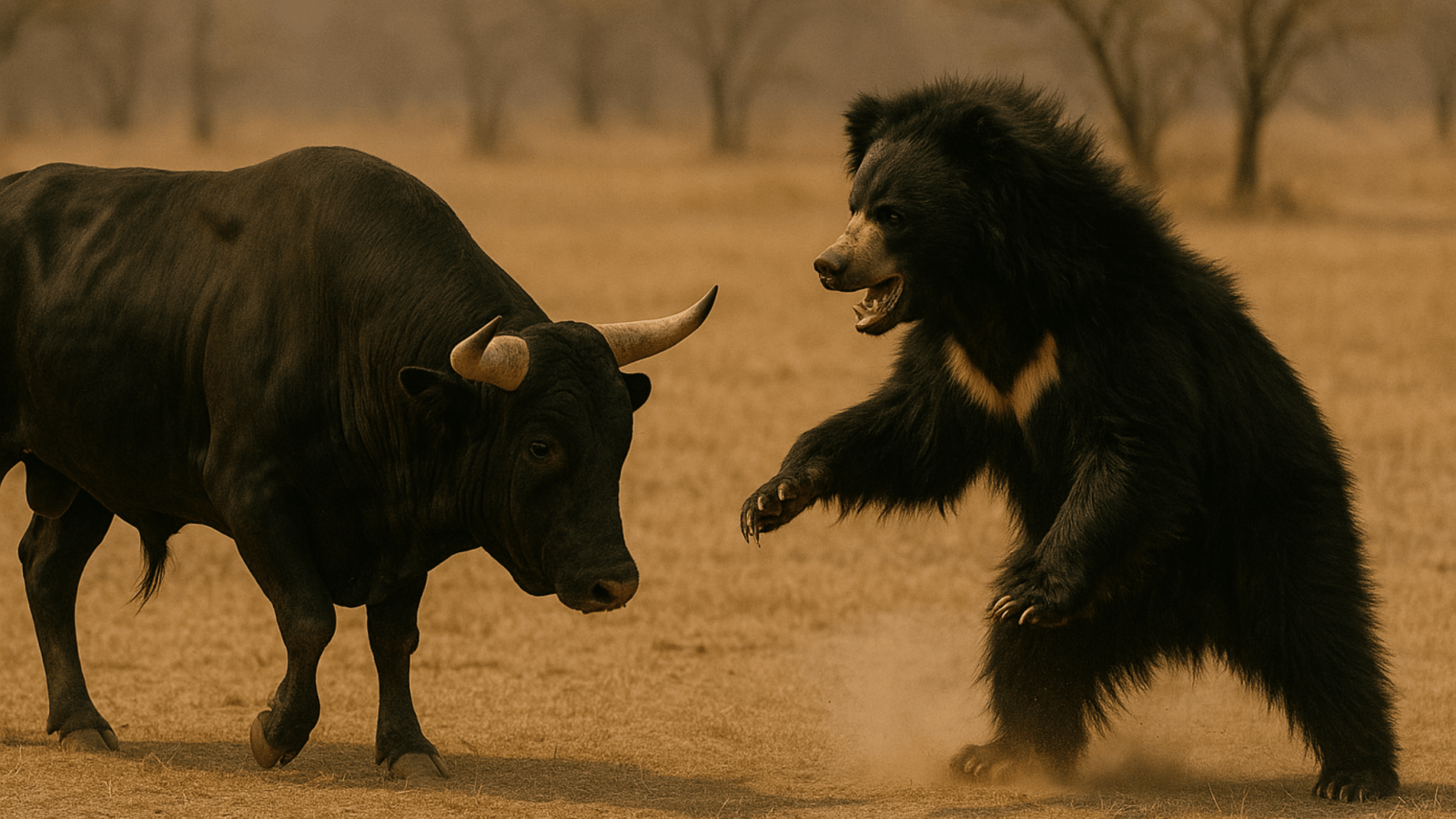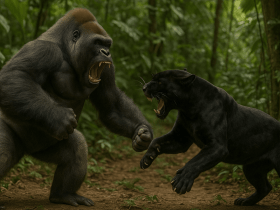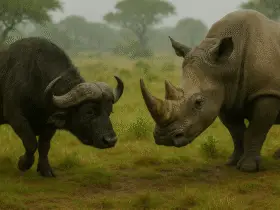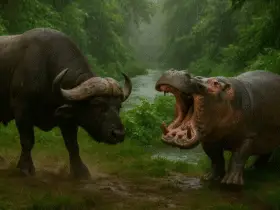A bull vs sloth bear. This may sounds like unfamiliar , but it’s definitely an interesting one! On one side, the bull a solid, ground-pounding herbivore built with muscle, stamina, and horns that mean business. On the other side, the sloth bear a shaggy, insect-eating mammal that’s surprisingly fierce and known for its powerful claws and unpredictable attitude.
Both of these mother nature creatures come from different lifestyles and living patterns, but if these two met face-to-face, who would come out on top? Let’s take a fun and detailed look at how their strength, defenses, and instincts compare in this unique animal comparison.
Let’s dive into this detailed comparison across 10 categories to find out that which animal holds the best features and abilities in a fight between a bull vs sloth bear.
1. Body Specifications
| Subtopic | Bull (Bos taurus) | Sloth Bear (Melursus ursinus) | Winner |
|---|---|---|---|
| Average Weight | 500–1,100 kg | 55–190 kg | Bull |
| Body Length | 2.4–2.8 meters | 1.4–1.9 meters | Bull |
| Height at Shoulder | 1.4–1.8 meters | 0.6–0.9 meters | Bull |
| Muscle Mass | Very high – bred for power | Moderate – leaner build | Bull |
| Bone Density | High – thick skeletal frame | Moderate – adapted for digging | Bull |
| Skull Structure | Thick, reinforced for ramming | Long, narrow with weak jaw muscles | Bull |
| Horn Length | Up to 60 cm (varies by breed) | No horns | Bull |
| Claw Size | Hooves (non-lethal) | Long claws up to 10 cm | Sloth Bear |
| Neck Strength | Extremely powerful | Strong but not built for ramming | Bull |
| Body Build | Stocky, muscular | Slender, shaggy | Bull |
Category Winner: Bull – Dominates in size, strength, and durability.
2. Coat and Coloration
| Subtopic | Bull | Sloth Bear | Winner |
|---|---|---|---|
| Primary Color | Black, brown, white, or mixed | Shaggy black with white chest patch | Draw |
| Coat Type | Short and coarse | Long, shaggy, and thick | Sloth Bear |
| Camouflage | Low – usually in open fields | Moderate – blends in forest shadows | Sloth Bear |
| Seasonal Shedding | Yes – varies with breed | Yes – seasonal molting | Draw |
| Protection Factor | Low – vulnerable to bites/claws | Offers minimal defense but good insulation | Sloth Bear |
| Heat Regulation | Poor in hot climates | Better adapted to Indian tropics | Sloth Bear |
| Parasite Resistance | Moderate (groomed by humans) | Uses trees, dust baths to remove insects | Sloth Bear |
| Sensory Hairs | None | Present on face and limbs | Sloth Bear |
| Water Resistance | Low | Moderate | Sloth Bear |
| Grooming Behavior | Rare – often brushed by handlers | Regular self-cleaning via scratching and baths | Sloth Bear |
Category Winner: Sloth Bear – More adapted for wild survival and heat tolerance.
3. Habitat and Range
| Subtopic | Bull | Sloth Bear | Winner |
|---|---|---|---|
| Geographic Range | Global (domesticated) | Indian subcontinent | Bull |
| Habitat Type | Farmlands, grasslands | Forests, grasslands, scrublands | Sloth Bear |
| Climate Preference | Temperate | Tropical and subtropical | Sloth Bear |
| Shelter Type | Barns, sheds | Tree hollows, caves, dug dens | Sloth Bear |
| Mobility Range | Limited to farms | Wide-ranging in wild | Sloth Bear |
| Altitude Range | Up to 3,000 m (some breeds) | Up to 2,000 m | Bull |
| Adaptability | High (man-managed environments) | Very adaptable in wild | Draw |
| Migration Behavior | None | Limited – seasonal food shifts | Sloth Bear |
| Human Proximity | Extremely high | Often found near villages | Bull |
| Habitat Degradation Risk | Low | High – deforestation threat | Bull |
Category Winner: Draw – Bulls dominate in managed environments, sloth bears in natural adaptability.
4. Diet and Hunting
| Subtopic | Bull | Sloth Bear | Winner |
|---|---|---|---|
| Diet Type | Herbivore – grasses, hay | Insectivore/omnivore | Sloth Bear |
| Preferred Foods | Grass, grains, silage | Termites, ants, honey, fruit | Sloth Bear |
| Foraging Technique | Grazing | Sniffing and clawing into mounds | Sloth Bear |
| Daily Calorie Intake | ~25,000 kcal/day | ~10,000–15,000 kcal/day | Bull |
| Hunting Ability | None | Poor, but can find insects efficiently | Sloth Bear |
| Feeding Duration | Several hours daily | Nocturnal forager | Draw |
| Food Competition | Low – fed by humans | Moderate – competes with other species | Bull |
| Water Dependence | High – needs frequent water | Moderate | Sloth Bear |
| Digestion Efficiency | High – ruminant digestive system | Good, adapted to insects and fruits | Bull |
| Opportunistic Feeding | No | Yes | Sloth Bear |
Category Winner: Sloth Bear – More versatile diet and better foraging tactics.
5. Strength and Bite Force
| Subtopic | Bull | Sloth Bear | Winner |
|---|---|---|---|
| Bite Force | Weak bite (herbivore) | ~300 PSI | Sloth Bear |
| Claw Strength | None – has hooves | High – used for breaking termite mounds | Sloth Bear |
| Neck Musculature | Very strong – supports heavy horns | Moderate | Bull |
| Limb Power | Extremely strong legs | Strong forelimbs – great for digging | Draw |
| Lifting Capability | Can lift 400+ kg when charging | Can tear apart logs and soil | Draw |
| Head Impact Force | Very high – powerful ramming | Low | Bull |
| Gripping Strength | None | Moderate – curved claws for hold | Sloth Bear |
| Upper Body Strength | Limited | Strong for size | Sloth Bear |
| Attack Damage Potential | High when charging | High if using claws | Draw |
| Body-to-Weight Power Ratio | High | High | Draw |
Category Winner: Draw – Bulls have raw force; sloth bears bring deadly claws and a strong bite.
6. Speed and Agility
| Subtopic | Bull | Sloth Bear | Winner |
|---|---|---|---|
| Top Speed | ~40–50 km/h | ~40 km/h | Bull |
| Acceleration | High – explosive start | Moderate | Bull |
| Maneuverability | Poor – not agile | Good – flexible in forests | Sloth Bear |
| Turning Radius | Wide – due to large body | Narrow | Sloth Bear |
| Endurance | Moderate – good for short bursts | High – used to long foraging | Sloth Bear |
| Climbing Ability | Cannot climb | Excellent climber | Sloth Bear |
| Swimming Ability | Poor swimmer | Poor to moderate | Draw |
| Terrain Adaptability | Flatland specialist | Rugged forest specialist | Sloth Bear |
| Reflex Speed | Slow | Fast | Sloth Bear |
| Flexibility | Very low | Moderate | Sloth Bear |
Category Winner: Sloth Bear – Much more agile and terrain-adapted.
7. Senses
| Subtopic | Bull | Sloth Bear | Winner |
|---|---|---|---|
| Vision | Moderate – can see movement | Poor – myopic vision | Bull |
| Hearing Range | Good – sensitive to sounds | Good | Draw |
| Sense of Smell | Moderate | Exceptional – used to detect termites from afar | Sloth Bear |
| Night Vision | Poor | Good – nocturnal activity | Sloth Bear |
| Sensory Hairs | Absent | Present | Sloth Bear |
| Detection Distance | Low | High – can detect food kilometers away | Sloth Bear |
| Environmental Awareness | Moderate | High | Sloth Bear |
| Sensory Processing | Simple (domestic) | Complex (wild survival) | Sloth Bear |
| Sensory Adaptation | Low | High | Sloth Bear |
| Balance and Coordination | Moderate | High – needed for climbing and digging | Sloth Bear |
Category Winner: Sloth Bear – Far superior sensory capabilities.
8. Reproduction and Lifespan
| Subtopic | Bull | Sloth Bear | Winner |
|---|---|---|---|
| Gestation Period | 280 days (cow) | 210 days | Sloth Bear |
| Litter Size | Usually 1 calf | 1–2 cubs | Sloth Bear |
| Sexual Maturity | 12–14 months (bull) | 3–4 years | Bull |
| Lifespan in Wild | N/A (domesticated) | 20 years | Sloth Bear |
| Lifespan in Captivity | 15–20 years | 25–30 years | Sloth Bear |
| Maternal Care | Minimal (managed by humans) | High – cubs stay with mother for 2–3 years | Sloth Bear |
| Parental Investment | Low | High | Sloth Bear |
| Cub Mortality Rate | N/A | Moderate – depends on habitat | Sloth Bear |
| Reproductive Frequency | Yearly (in managed systems) | Every 2–3 years | Bull |
| Breeding Season | Artificial (controlled breeding) | Natural cycles | Sloth Bear |
Category Winner: Sloth Bear – More adapted to natural reproduction and longevity.
9. Social Behavior
| Subtopic | Bull | Sloth Bear | Winner |
|---|---|---|---|
| Social Structure | Herd-based (domesticated) | Solitary | Draw |
| Territorial Range | Confined (human-controlled) | Large – marks and defends territory | Sloth Bear |
| Aggression Display | High during mating or provocation | Highly defensive | Draw |
| Communication Method | Vocal, body language | Grunts, snorts, roars, and body posture | Draw |
| Conflict Behavior | Charges with head | Stands ground, slashes with claws | Sloth Bear |
| Grooming Behavior | None (handled by humans) | Self-grooming | Sloth Bear |
| Family Units | None – raised separately | Mother-cub units | Sloth Bear |
| Social Intelligence | Low | Moderate | Sloth Bear |
| Human Tolerance | High | Low to moderate | Bull |
| Play Behavior | Rare | Observed in young bears | Sloth Bear |
Category Winner: Sloth Bear – Exhibits more complex natural social traits.
10. Conservation Status
| Subtopic | Bull | Sloth Bear | Winner |
|---|---|---|---|
| IUCN Status | Not Evaluated (domesticated) | Vulnerable | Bull |
| Population Trend | Increasing | Decreasing | Bull |
| Major Threats | None (farmed) | Poaching, habitat loss, human conflict | Bull |
| Legal Protection | None needed | Protected under Indian Wildlife Act | Sloth Bear |
| Habitat Fragmentation | Not affected | Severely affected | Bull |
| Human-Wildlife Conflict | None | High | Bull |
| Conservation Programs | None | Active (NGOs, Indian government) | Sloth Bear |
| Captive Breeding | Industrial | Limited success | Bull |
| Endangered Status Risk | Zero | High | Bull |
| Public Awareness | High (livestock) | Moderate | Bull |
Category Winner: Bull – Not under any ecological threat.
Interesting Facts –
Bull
-
Bulls have a natural instinct to attack when threatened, using their momentum and horns to defeat the opponents.
-
Their hooves are very tough and sharp enough to cause serious injury during fights.
-
Bulls sweat through their skin pores, which helps regulate their body temperature during intense physical activity.
-
They have a strong sense of territory and use scent marking to warn rivals.
-
Bulls can lower their heads and lock horns to push opponents in dominance battles.
Sloth Bear
-
Sloth bears have long, curved claws designed for digging termite mounds and ripping apart logs.
-
They have a unique gap in their front teeth that allows them to suck up insects like a vacuum.
-
Unlike many bears, sloth bears are mostly nocturnal and avoid direct confrontations.
-
They can emit loud, guttural roars and growls to intimidate threats.
-
Sloth bears have a shaggy coat that helps protect them from insect bites and harsh underbrush.
Face-to-Face Fight: Bull vs Sloth Bear
In a direct fight, the outcome would depend on many real-world variables such as environment, surprise, and age of the animals.
- The Bull comes with immense weight, a brutal charge, and sheer strength. One well-placed gore could knock down the sloth bear permanently.
- The Sloth Bear, though smaller, has sharp claws, a strong bite, quick reflexes, and aggressive defensive tactics. If it can avoid the initial charge and stay close to the bull’s blind side, it might claw at vulnerable spots like the neck or face.
Outcome:
In most cases, the bull has the advantage due to size and offensive power. However, a sloth bear could potentially win in dense forest terrain where agility, surprise, and claw strikes matter more.
Winner in a Neutral Arena: Bull
Final Verdict: Bull Wins
Why the Bull Wins:
- Overwhelming size and power – Up to 1,000+ kg body weight
- Lethal charge – High-speed impact with horn force
- Thick body and bones – Can absorb multiple sloth bear strikes
- Faster in open terrain
Why the Sloth Bear Loses:
- Too light to cause lasting damage to a bull’s mass
- Claws are dangerous but less effective against thick hides
- Would struggle in open spaces without cover
References (Short, Simple with Links)
- Animal Diversity Web – Melursus ursinus
https://animaldiversity.org/accounts/Melursus_ursinus/ - National Geographic – Sloth Bear Facts
https://www.nationalgeographic.com/animals/mammals/facts/sloth-bear - ILRI – Cattle and Bull Characteristics
https://www.ilri.org/research/facilities/cattle-breeds - BBC Earth – Bulls and Livestock Behavior
https://www.bbcearth.com/news/bull-behavior-and-strength - IUCN Red List – Sloth Bear Status
https://www.iucnredlist.org/species/13143/45033815
Find More – Sloth Bear Battles






Leave a Reply